-
Ansible概述以及模块
目录
一、Ansible概述
1、Ansible是什么
Ansible是一个基于Python开发的配置管理和应用部署工具,现在也在自动化管理领域大放异彩。它融合了众多老牌运维工具的优点,Pubbet和Saltstack能实现的功能,Ansible基本上都可以实现。
2、Ansible的作用
Ansible能批量配置、部署、管理上千台主机。比如以前需要切换到每个主机上执行的一或多个操作,使用Ansible只需在固定的一台Ansible控制节点上去完成所有主机的操作。
3、Ansible的特性
- Ansible其中一个比较鲜明的特性是Agentless,即无Agent的存在,它就像普通命令一样,并非C/S软件,也只需在某个作为控制节点的主机上安装一次Ansible即可,通常它基于ssh连接来控制远程主机,远程主机上不需要安装Ansible或其它额外的服务。
- 使用者在使用时,在服务器终端输入命令或者playbooks,会通过预定好的规则将playbook拆解为play,再组织成ansible可以识别的任务,调用模块和插件,根据主机清单通过SSH将临时文件发给远程的客户端执行并返回结果,执行结束后自动删除
- 使用者在使用时,在服务器终端输入命令或者playbooks,会通过预定好的规则将playbook拆解为play,再组织成ansible可以识别的任务,调用模块和插件,根据主机清单通过SSH将临时文件发给远程的客户端执行并返回结果,执行结束后自动删除
- Ansible的另一个比较鲜明的特性是它的绝大多数模块都具备幂等性(idempotence)。所谓幂等性,指的是多次操作或多次执行对系统资源的影响是一致的。比如执行 systemctl stop xxx 命令来停止服务,当发现要停止的目标服务已经处于停止状态, 它什么也不会做,所以多次停止的结果仍然是停止,不会改变结果,它是幂等的,而 systemctl restart xxx 是非幂等的。
Ansible的很多模块在执行时都会先判断目标节点是否要执行任务,所以,可以放心大胆地让Ansible去执行任务,重复执行某个任务绝大多数时候不会产生任何副作用。
4、Ansible的工作机制
Ansible是基于模块工作的,它只是提供了一种运行框架,它本身没有完成任务的能力,真正执行操作的是Ansible的模块, 比如copy模块用于拷贝文件到远程主机上,service模块用于管理服务的启动、停止、重启等。
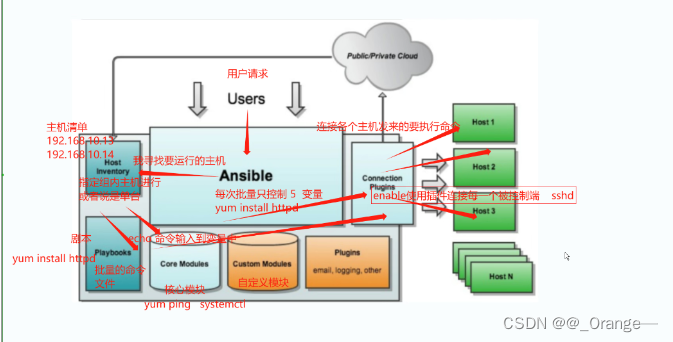
-
Ansibe:核心组件 核心程序
-
host Inventory:记录有ansibe管理的主机信息(包括端口、IP、密码等。)
-
playbook:”剧本“ YAML格式文件,多个任务定义在一个文件中,定义主机需要哪些模块完成任务
-
core modules:核心模块,主要通过调用核心的模来管理任务
-
custo modlues:自定义模块,完成核心模块无法完成的功能。支持多个语言
-
connection Plugins:连接插件 ansible和HOST通信使用
5、Ansible的特点
- 部署简单,只需在主控端部署Ansible环境, 被控端无需做任何操作
- 默认使用SSH协议设备进行管理;
- 主从集中化管理
- 配置简单、功能强大、扩张性强;
- 支持API及自定义模块,可以通过Pyhton轻松扩展
- 通过playbooks 来定制强大的配置、状态管理
- 对云计算平台、大数据都有很好的支持
二、Ansible安装部署
管理端: 192.168.247.10 ansible 被管理端1: 192.168.247.22 被管理端2: 192.168.247.23 1、管理端安装ansible
- yum install -y epel-release //先安装 epel 源
- yum install -y ansible
- 先安装epel源

- yum安装ansible

安装好后在 /etc/ansible目录下会生成三个文件:
- ansible.cfg:ansible的配置文件,一般无需修改
- hosts:ansible的主机清单,用于存储需要管理的远程主机的相关信息
- roles:公共角色目录

2、配置主机清单
- cd /etc/ansible
- vim hosts
- [webservers] #配置组名
- 192.168.247.22 #组里包含的被管理的主机IP地址或主机名(主机名需要先修改/etc/hosts文件)
- [dbservers]
- 192.168.247.23
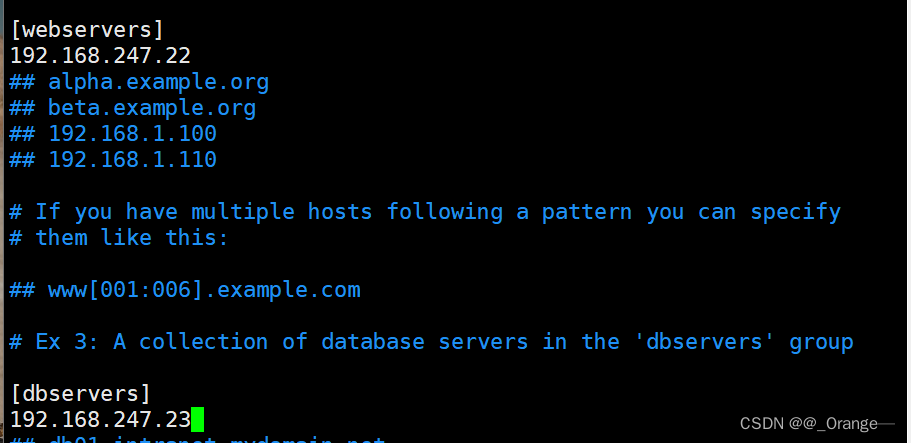
3、配置密钥对验证
- ssh-keygen -t dsa #一路回车,使用免密登录
- ssh-copy-id -i /root/.ssh/id_dsa.pub root@192.168.247.22
- ssh-copy-id -i /root/.ssh/id_dsa.pub root@192.168.247.23


三、Absible命令行模块
- 命令格式:ansible <组名> -m <模块> -a <参数列表>
- ansible-doc -l #列出所有已安装的模块,按q退出
1、command模块
在远程主机执行命令,不支持管道,重定向等shell的特性。
- ansible-doc -s command #-s 列出指定模块的描述信息和操作动作
- ansible 192.168.247.22 -m command -a 'date' #指定 ip 执行 date
- ansible webservers -m command -a 'date' #指定组执行 date
- ansible dbservers -m command -a 'date'
- ansible all -m command -a 'date' #all 代表所有 hosts 主机
- ansible all -a 'ls /' #如省略 -m 模块,则默认运行 command 模块

常用参数:
- chdir:在远程主机上运行命令前提前进入目录
- creates:判断指定文件是否存在,如果存在,不执行后面的操作
- removes:判断指定文件是否存在,如果存在,执行后面的操作

2、shell模块
在远程主机执行命令,相当于调用远程主机的shell进程,然后在该shell下打开一个子shell运行命令(支持管道符号等功能)
- ansible-doc -s shell #-s 列出指定模块的描述信息和操作动作
- ansible dbservers -m shell -a 'echo 123456 | passwd --stdin test'
- ansible dbservers -m shell -a 'echo $(ifconfig ens33 | awk "NR==2 {print $2}") | cut -d " " -f2'
- ansible dbservers -m shell -a 'echo $(ifconfig ens33 | awk "NR==2 {print \$2}")'

可用选项:
- chdir:切换目录
- cmd:要运行的命令,后跟可选参数
- creates:判断指定文件是否存在,如果存在,不执行后面的操作
- executable:更改用于执行命令的shell。这需要一个可执行文件的绝对路径。
- free_from:Shel模块接受一个自由形式的命令以字符串的形式运行
- removes:判断指定文件是否存在,如果存在,执行后面的操作
- stdin:直接将命令的stdin设置为指定值
- stdin_add_newline:是否在stdin数据中追加换行符
- warn:是否启用任务警告
- ansible dbservers -m shell -a 'echo 123456 | passwd --stdin test'
- ansible dbservers -m shell -a 'echo $(ifconfig ens33 | awk "NR==2 {print $2}")

- executable命令示例:
ansible 192.168.247.23 -m shell -a '/opt/ceshi.sh' -e 'executable=/bin/bash'

3、cron 模块
在远程主机定义任务计划。其中有两种状态(state):present表示添加(可以省略),absent表示移除。
ansible-doc -s cron #按 q 退出常用参数:
- minute/hour/day/month/weekday:分/时/日/月/周
- job:任务计划要执行的命令
- name:任务计划的名称
- ansible webservers -m cron -a 'minute="*/1" job="/bin/echo helloworld" name="test crontab"'
- ansible webservers -a 'crontab -l'
- ansible webservers -m cron -a 'name="test crontab" state=absent' #移除计划任务,假如该计划任务没有取名字,name=None即可


4、user 模块
用户管理的模块
ansible-doc -s user #-s 列出指定模块的描述信息和操作动作常用的参数:
- name:用户名,必选参数
- state=present|absent:创建账号或者删除账号,present表示创建,absent表示删除
- system=yes|no:是否为系统账号
- uid:用户uid
- group:用户基本组
- shell:默认使用的shell
- move_home=yse|no:如果设置的家目录已经存在,是否将已经存在的家目录进行移动
- password:用户的密码,建议使用加密后的字符串
- comment:用户的注释信息
- remove=yes|no:当state=absent时,是否删除用户的家目录
- ansible webservers -m user -a 'name="test01"' #创建用户test01
- ansible webservers -m command -a 'tail /etc/passwd' #查看用户test01
- ansible webservers -m user -a 'name="test01" state=absent' #删除用户test01
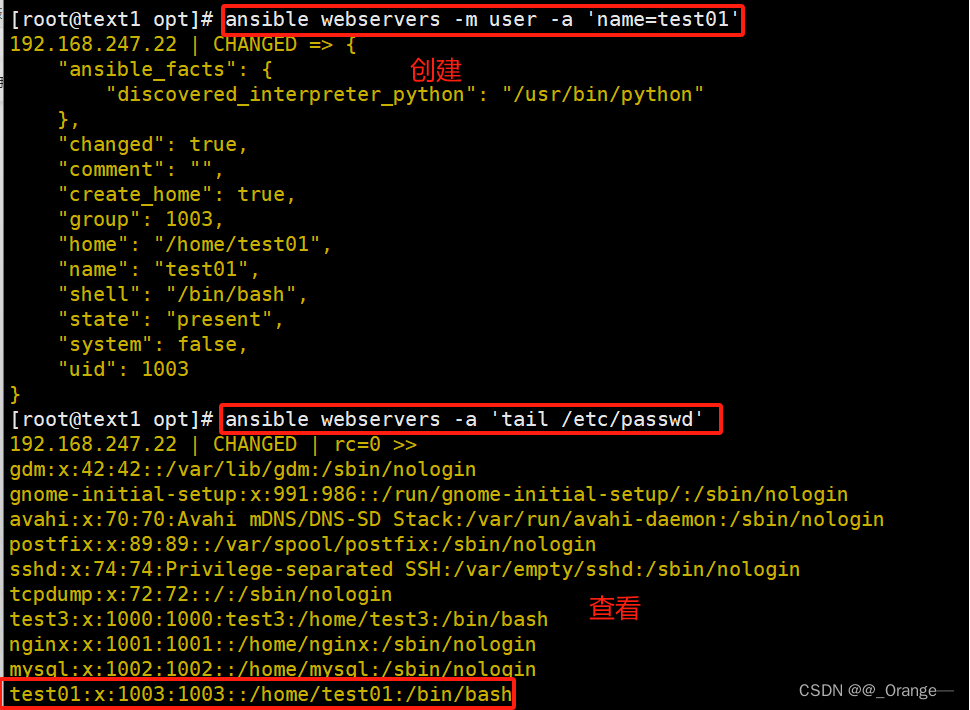
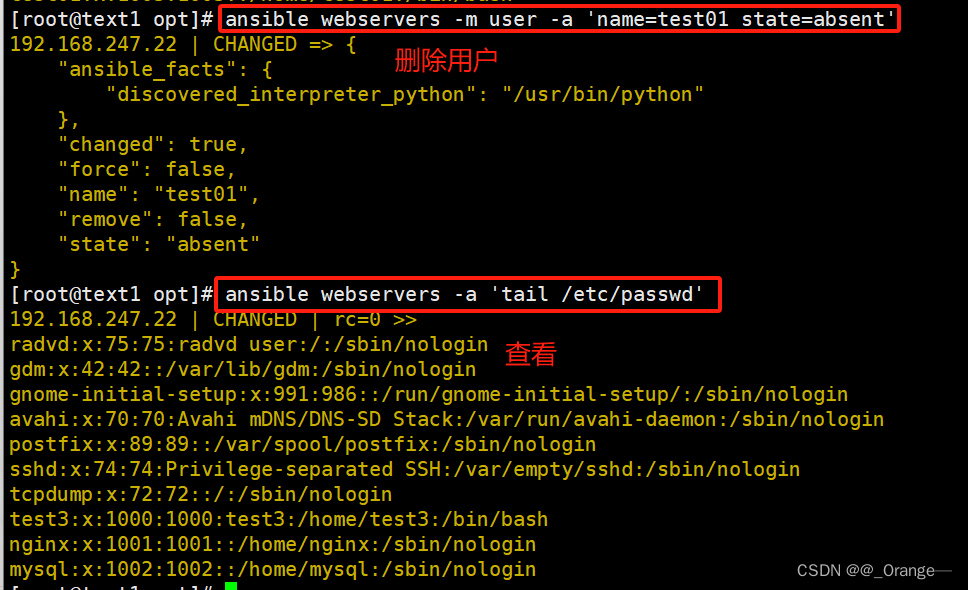
5、group 模块
用户组管理的模块
ansible-doc -s group- ansible webservers -m group -a 'name=mysql gid=306 system=yes' #创建mysql组
- ansible webservers -a 'tail /etc/group' #查看创建的组
- ansible webservers -m user -a 'name=test01 uid=306 system=yes group=mysql' #将test01用户添加到mysql组中
- ansible webservers -a 'tail /etc/passwd'
- ansible webservers -a 'id test01'
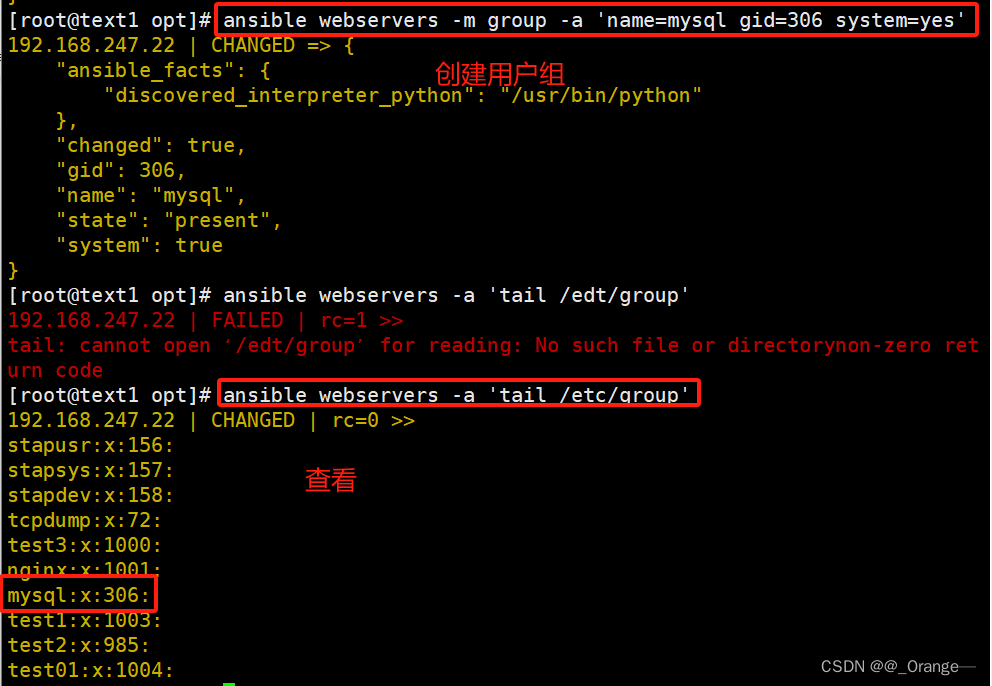
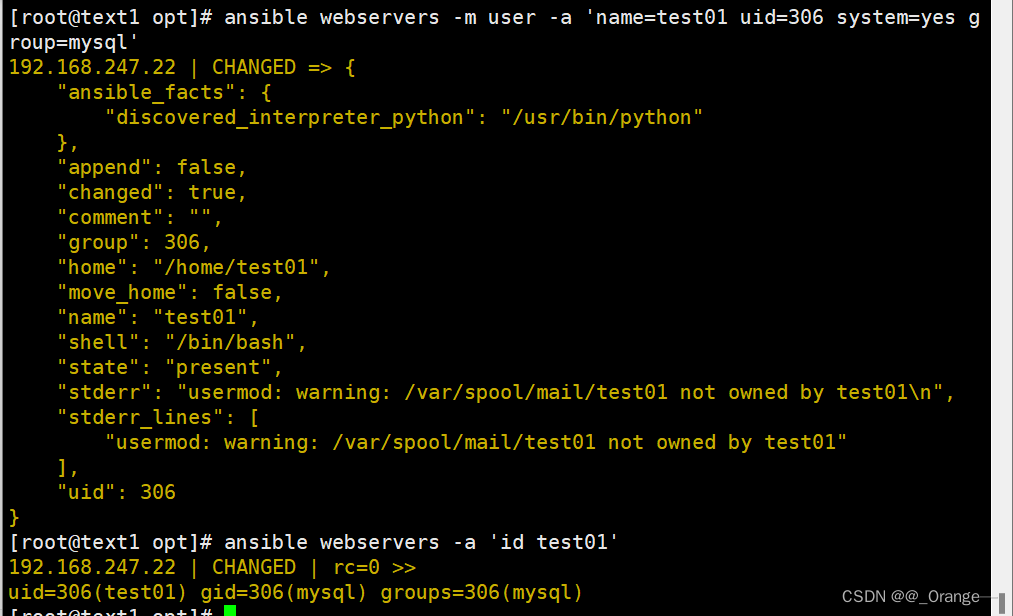
6.copy 模块
用于复制指定主机文件到远程主机的
ansible-doc -s copy常用的参数:
- dest:指出复制文件的目标及位置,使用绝对路径,如果是源目录,指目标也要是目录,如果目标文件已经存在会覆盖原有的内容
- src:指出源文件的路径,可以使用相对路径或绝对路径,支持直接指定目录,如果源是目录则目标也要是目录
- mode:指出复制时,目标文件的权限
- owner:指出复制时,目标文件的属主
- group:指出复制时,目标文件的属组
- content:指出复制到目标主机上的内容,不能与src一起使用
- ansible dbservers -m copy -a 'src=/etc/fstab dest=/opt/fstab.bak owner=root mode=640'
- ansible dbservers -a 'ls -l /opt'
- ansible dbservers -a 'cat /opt/fstab.bak'
- ansible dbservers -m copy -a 'content="helloworld" dest=/opt/hello.txt' #将helloworld写入/opt/hello.txt文件中
- ansible dbservers -a 'cat /opt/hello.txt'
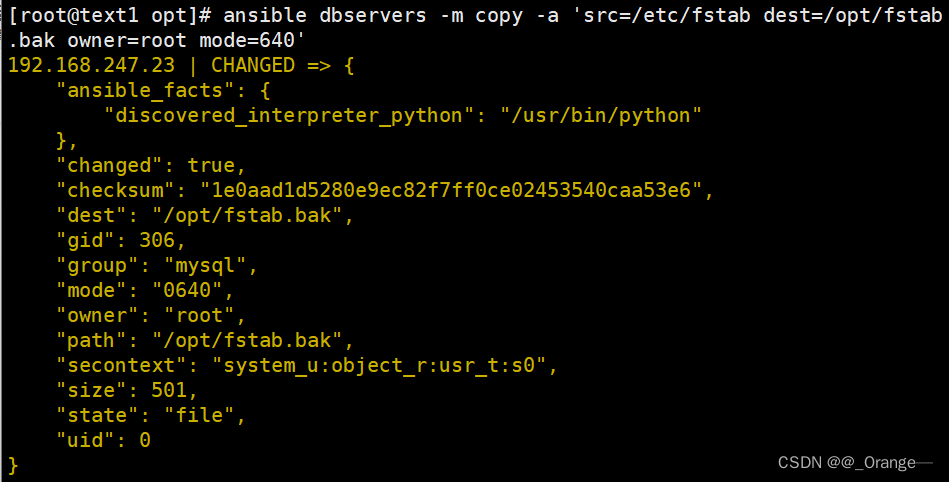

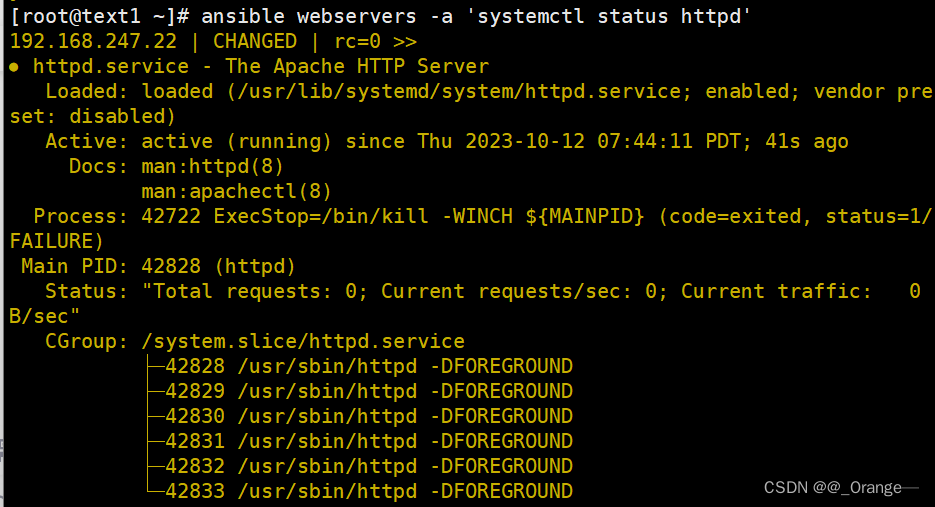
7、file 模块
设置文件属性
ansible-doc -s file- ansible dbservers -m file -a 'owner=test01 group=mysql mode=644 path=/opt/fstab.bak' #修改文件的属主属组权限等
- ansible dbservers -m file -a 'path=/opt/fstab.link src=/opt/fstab.bak state=link' #设置/opt/fstab.link为/opt/fstab.bak的链接文件
- ansible dbservers -m file -a "path=/opt/abc.txt state=touch" #创建一个文件
- ansible dbservers -m file -a "path=/opt/abc.txt state=absent" #删除一个文件


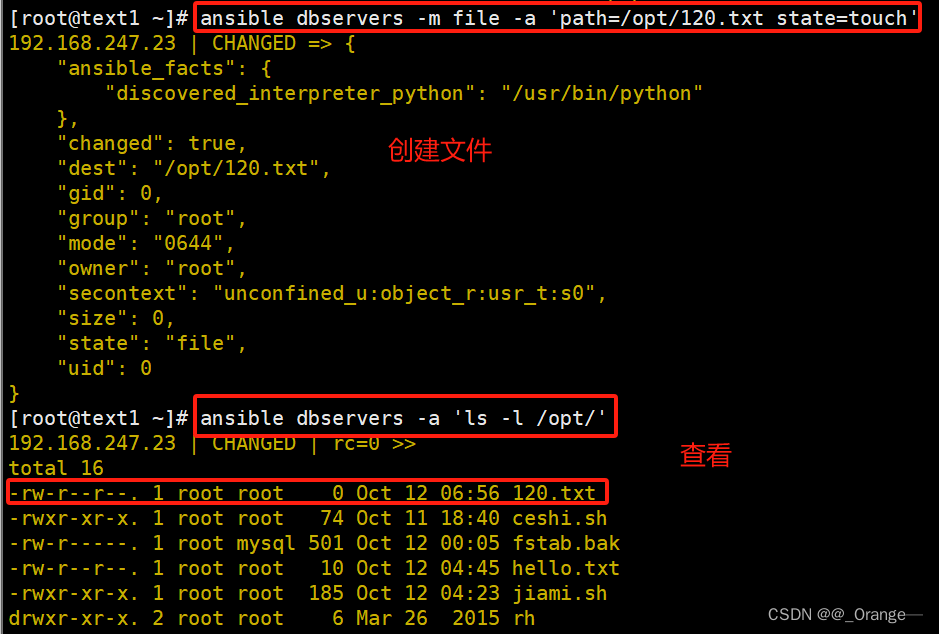

8、hostname 模块
用于管理远程主机上的主机名
ansible dbservers -m hostname -a "name=mysql01"

9、ping 模块
检测远程主机的连通性
ansible all -m ping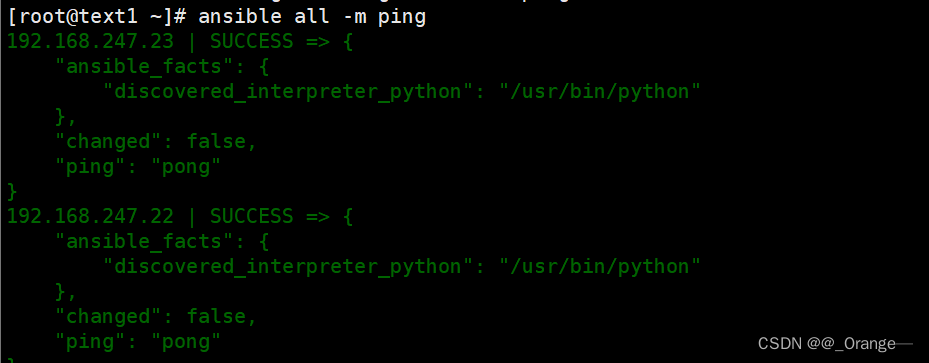
10、yum 模块
在远程主机上安装与卸载软件包
ansible-doc -s yum- ansible webservers -m yum -a 'name=httpd' #安装服务
- ansible webservers -m yum -a 'name=httpd state=absent' #卸载服务



11、service/systemd 模块
用于管理远程主机上的管理服务的运行状态
ansible-doc -s service常用的参数:
- name:被管理的服务名称
- state=started|stopped|restarted:动作包含启动关闭或者重启
- enabled=yes|no:表示是否设置该服务开机自启
- runlevel:如果设定了enabled开机自启去,则要定义在哪些运行目标下自启动
- ansible webservers -a 'systemctl status httpd' #查看web服务器httpd运行状态
- ansible webservers -m service -a 'enabled=true name=httpd state=started' #启动httpd服务



12、script 模块
实现远程批量运行本地的 shell 脚本
ansible-doc -s script- vim test.sh
- #!/bin/bash
- echo "hello ansible from script" > /opt/script.txt
- chmod +x test.sh
- ansible webservers -m script -a 'test.sh'
- ansible webservers -a 'cat /opt/script.txt'

13.setup 模块
facts 组件是用来收集被管理节点信息的,使用 setup 模块可以获取这些信息
- ansible webservers -m setup #获取mysql组主机的facts信息
- ansible dbservers -m setup -a 'filter=*ipv4' #使用filter可以筛选指定的facts信息


四、inventory主机清单
Inventory支持对主机进行分组,每个组内可以定义多个主机,每个主机都可以定义在任何一个或多个主机组内。
如果是名称类似的主机,可以使用列表的方式标识各个主机。
- vim /etc/ansible/hosts
- [webservers]
- 192.168.10.14:2222 #冒号后定义远程连接端口,默认是 ssh 的 22 端口
- 192.168.10.1[2:5] #匹配范围为192.168.10.12---192.168.10.15
- 192.168.10.[11:30] #匹配范围为192.168.10.11---192.168.10.30
- [dbservers]
- db-[a:f].example.org #支持匹配 a~f
inventory 中的变量
Inventory变量名 含义 ansible_host ansible连接节点时的IP地址 ansible_port 连接对方的端口号,ssh连接时默认为22 ansible_user 连接对方主机时使用的主机名。不指定时,将使用执行ansible或ansible-playbook命令的用户 ansible_password 连接时的用户的ssh密码,仅在未使用密钥对验证的情况下有效 ansible_ssh_private_key_file 指定密钥认证ssh连接时的私钥文件 ansible_ssh_common_args 提供给ssh、sftp、scp命令的额外参数 ansible_become 允许进行权限提升 ansible_become_method 指定提升权限的方式,例如可使用sudo/su/runas等方式 ansible_become_user 提升为哪个用户的权限,默认提升为root ansible_become_password 提升为指定用户权限时的密码 1、主机变量
- [webservers]
- 192.168.247.70 ansible_port=22 ansible_user=root ansible_password=abc1234


2、组变量
- [webservers:vars] #表示为 webservers 组内所有主机定义变量
- ansible_user=root
- ansible_password=abc1234
- [all:vars] #表示为所有组内的所有主机定义变量
- ansible_port=22
3、组嵌套
- [nginx]
- 192.168.10.20
- 192.168.10.21
- 192.168.10.22
- [apache]
- 192.168.10.3[0:3]
- [webs:children] #表示为 webs 主机组中包含了 nginx 组和 apache 组内的所有主机
- nginx
- apache
-
相关阅读:
Spring Boot Bean 注入的常用方式教程
Linux系统中安装Redis
不要只成为PID调参工程师
在不损失质量的情况下减小PDF 文件大小的 6 种方法
JDK17 ReentrantLock 简述 lock()、unLock()
Python|OpenCV-如何给目标图像添加边框(7)
电脑文件自动备份到u盘,怎么实现?
针对大型商场的现状,3d全景有哪些解决方案?
java计算机毕业设计美容院业务管理系统源码+系统+mysql数据库+lw文档
SHELL脚本编程----netstat练习2-查看和3306端口建立的连接
- 原文地址:https://blog.csdn.net/weixin_46254171/article/details/133776229